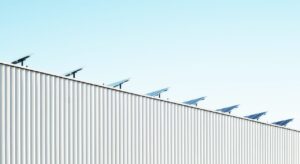A solar power plant is an engineering structure that is used to convert solar energy (radiation, radiation, light) into useful electrical energy. Modern ways of converting solar energy are very different and depend on the design of a particular solar power plant.
The main element of the solar power plant is a photovoltaic panel (PV – photovoltaic panel), which consists of a chain of photovoltaic cells – semiconductor devices that convert solar energy directly into electrical current. The process of converting solar energy into electric current is called the photovoltaic effect.
A semiconductor is a material that either has extra electrons in its atoms (n-type) or, conversely, lacks them (p-type). Accordingly, a semiconductor photocell consists of two layers with different conductivities. The n-layer is used as the cathode and the p-layer as the anode.
Excess electrons from the n-layer can leave their atoms, while the p-layer captures these electrons. It is the rays of light that “knock out” electrons from the atoms of the n-layer, after which they fly into the p-layer to occupy the empty spaces. In this way, the electrons run in a circle, leaving the p-layer, passing through the load (in this case the battery) and returning to the n-layer.
There are three possible uses for solar power plants:
SES for own use
grid-connected solar power plants
Combined solar power plants
SES for own use are designed to reduce the consumption of electricity from the grid and provide for the transformation of solar radiation into electrical energy, in order to use it only for the needs of a particular facility. These SPSs do not provide the possibility of selling (transferring) the generated electricity to other users or to the network of the local power company, as well as the accumulation of generated electricity with the help of batteries (Batteries).
Network solar plants are designed to reduce consumption of electric power from the grid or to generate electric power to the grid and then sell the excess of generated electric power to the local power company’s grid at the “green tariff”. A grid-connected solar power plant does not have the option of storing the generated electricity and is not equipped with a battery.
Combined solar plants are designed to reduce the consumption of electricity from the grid or to generate electricity to the grid and then sell the excess generated electricity to the local utility grid at the “green tariff” or accumulate generated electricity with the help of storage batteries (Batteries).
Converting solar energy into heat, work and electricity
The Sun is a giant luminary with a diameter of 1,392,000 km. Its mass (2*10 30 kg) is 333 thousand times the mass of the Earth and its volume is 1.3 million times the volume of the Earth. The chemical composition of the Sun is 81.76% hydrogen, 18.14% helium and 0.1% nitrogen. The average density of the Sun is 1400 kg/m3. Inside the sun there are thermonuclear reactions of the conversion of hydrogen into helium, and every second 4 billion kilograms of matter are converted into energy, which is emitted by the sun into space in the form of electromagnetic waves of different lengths.
People have been using solar energy since ancient times. As early as 212 A.D. concentrated sunlight was used to light a sacred fire near the temples. According to legend Around the same time, the Greek scientist Archimedes set fire to the sails of the Roman navy while defending his hometown.
Solar energy can be converted into thermal, mechanical and electrical energy, used in chemical and biological processes. Solar plants are used in heating and cooling systems in residential and public buildings, in technological processes at low, medium and high temperatures. They are used for hot water production, desalination of seawater or mineralized water, drying of materials and agricultural products, etc. Solar energy enables photosynthesis, plant growth and various photochemical processes.
Solar energy is converted into electrical energy at solar power plants (SPPs) with equipment designed to capture solar energy and its sequential conversion into heat and electricity. Efficient operation of solar power plants (SPPs) requires a heat accumulator and an automatic control system.


